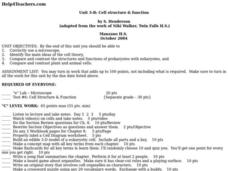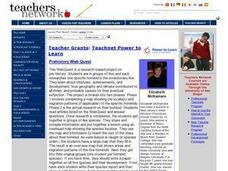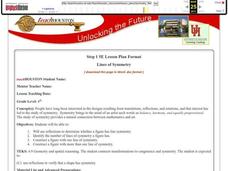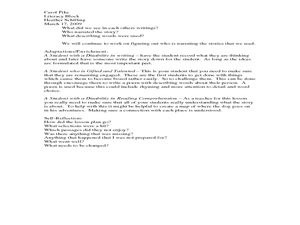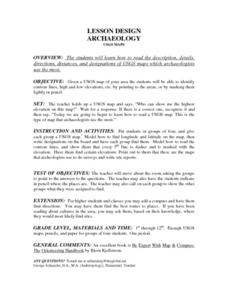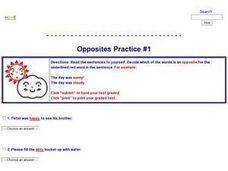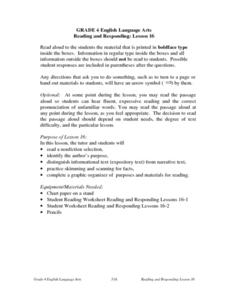Curated OER
Cell Structure and Function
Students identify the main ideas of different cell theories. Using a microscope, they compare and contrast the structures and functions of prokaryotes and eukaryotes. They also compare and contrast animal and plant cells and complete...
Curated OER
SATP Multiple Choice II
Learners explore strategies of identifying answers when given a multiple choice reading comprehension exam. Through a lecture and demonstration, students practice active reading by reading carefully, writing notes, and rereading. They...
Curated OER
Mechanical Properties of Chocolate: How Hard is your Chocolate?
Students calculate, measure and identify the hardness of various chocolate bars. They determine the hardness of the chocolate bar using quantitative data. Students make observations of the hardness of chocolate while dropping the...
Curated OER
Prehistory Web Quest
Sixth graders identify how geography and climate determine the lives of early hominids, the characteristics of hunter-gatherer societies, how animals affected the lives of early hominids, and how hominids overcame their physical...
Curated OER
Nuclear Fleas
Seventh graders distinguish characteristics of living things and identify the importance of careful observation. They identify five things that are not alive, but display characteristics of life and list five things that are alive, but...
Curated OER
Life of a Logger
Students are introduced to the work and lives of 19th century lumberjacks through a living history slide show presentation. They compare and contrast life 150 years ago with the present. Students describe the history of logging in...
Curated OER
What Do People Know About Radon?
In this radon worksheet, students read a short newspaper article about radon. Students complete 7 pages of exercises about the article. Students answer questions, define words, conduct a survey and tally the data.
Curated OER
Lines of Symmetry
Fourth graders identify lines of symmetry using reflections and then construct figures that have one or more lines of symmetry. In this symmetry lesson plan, 4th graders use sets of shapes, pattern blocks, a mirror, and more.
Curated OER
Describing Our Senator
Third graders find the narrator or speaker in a story. In this story elements lesson, 3rd graders listen to the story My Senator and Me and answer comprehension questions. They complete a descriptive writing piece from different...
Curated OER
Business Ownership
Students should identify and define the three basic forms of private business ownership.
Curated OER
Genre Jeopardy
Young scholars play a Jeopardy game in which the questions are about different genres. They can use this activity as a review before a test.
Curated OER
Dichotomous Chips
Students create a dichotomous key to different varieties of potato chips. In small groups, they observe and record characteristics of the potato chips to use in the key. They switch keys with another group to see if they can identify an...
Curated OER
Lesson Design Archaeology- USGS Maps
Students research USGS maps and identify the major features. In this map skills lesson, students identify low and high elevations on a USGS map and practice finding latitude and longitude.
Curated OER
Bigger than Life
Students explore courage. In this moral and character development lesson, students read biographical information about Jackie Robinson and identify examples of courage exemplified in his life story.
Curated OER
Utah at the Crossroads: Challenges for K-12 Education in the Coming Ten Years
Students discuss the difficulties in financing public education in Utah. They examine how Utah students perform on standardized tests. They focus on the coming enrollment boom in K-12 education and slowing economy and what effects these...
Curated OER
Opposites Practice #1
In this online interactive opposites worksheet, students respond to 12 multiple choice questions that require them to identify antonyms of the bold-faced words in 12 sentences. Students may submit their...
Curated OER
Creek Restoration Project
Students gather and analyze scientific data from a local creek. Over weeks or months, students observe their local environment, collect water samples, and evaluate test results. Extension activities are suggested for evaluating...
Curated OER
Credit: Buy Now & Pay Later
Learners examine credit and how it works. In this financial literacy lesson, students review the pros and cons of credit in order to purchase goods and services by answering provided questions and working within a group to come up with a...
Curated OER
Religious Revival: The American Response to the Cold War
Students examine the impact of religion on the Cold War. In this Cold War lesson, students analyze speeches delivered by Lenin, Truman, and Graham regarding the role of religion in society. As a culminating activity, students are tested...
Curated OER
Using Trigonometric Ratios
Young scholars solve problems using sine and cosine. For this trigonometry lesson, students apply the properties of sine and cosine to solve triangular problems. They identify when to use law of sines using angle-side relationships.
Curated OER
Chemistry E3 Lesson Plan
Ninth graders perform a series of experiment to investigate heat transfer and phase changes. In this physical science activity, 9th graders identify and calculate the different subatomic particles. They explain the importance of...
Alabama Learning Exchange
Graphing Stations
Students explore the concept of graphing stations. For this graphing stations lesson, students head to various teacher set-up stations involving slope, point-slope, standard form, parallel lines, etc. Students work problems...
Curated OER
Social Entrepreneurship
Students define the term "social entrepreneurs" and research several examples of this concept in action. They, in groups, research and discuss several questions.
Curated OER
Reading and Responding -- Lesson 16
Fourth graders work independently or in a small group to (1) read a nonfiction selection, (2) identify the author's purpose, (3) distinguish informational text from narrative text, (4) skim and scan for facts, and (5) complete a graphic...
